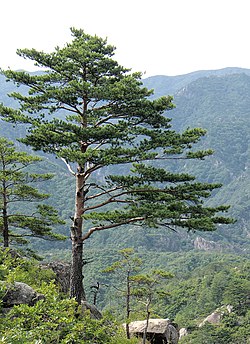Pinus densiflora
Pinus densiflora, also called the Japanese red pine,[1] Korean Pine tree or the Korean red pine,[2] has a home range that includes Japan, the Korean Peninsula, northeastern China (Heilongjiang, Jilin, Liaoning, Shandong) and the extreme southeast of Russia (southern Primorsky Krai). This pine has become a popular ornamental and has several cultivars, but in the winter it becomes yellowish. The height of this tree is 20–35 metres (66–115 feet). The plant prefers full sun on well-drained, slightly acidic soil.
In Korea, simply called sonamu (소나무, literally "pine tree"), it takes special status. Historically, Korean dynasties looked after timber and resin production banning laypeople from logging them. Korean aristocrats, or Yangban, loved it because they thought this evergreen tree represented virtues of Confucianism, "fidelity" and "fortitude". In this strongly Confucian society, it became the national symbol. For the Korean people, even today, it is considered to represent Korean spirit and mentioned in the South Korean national anthem, Aegukga. Since it was introduced to the West by Japanese scholars, it was named the "Japanese red pine" in English. In Korea, the Korea Forest Service has changed the English name to 'Korean red pine'.[3]
ReferencesEdit
- ↑ Template:PLANTS
- ↑ English Names for Korean Native Plants (PDF). Pocheon: Korea National Arboretum. 2015. p. 575. ISBN 978-89-97450-98-5. Archived from the original (PDF) on 25 May 2017. Retrieved 8 December 2016 – via Korea Forest Service.
- ↑ "Korea's native plants to find new names". koreatimes. 2015-08-11. Retrieved 2016-05-07.
